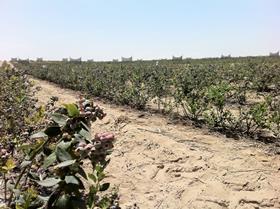
Peru’s burgeoning blueberry export industry will have to overcome a number of key challenges if it is to expand profitably in the years to come. That was the conclusion of Federico Beltrán of Terra Business, a consultancy representing Fall Creek Farm & Nursery in the Andean nation, who said it was important for growers to manage their expectations about the industry’s potential going forward.
Speaking during a blueberry workshop at this year’s Eurofruit Southern Hemisphere Congress, which was held in Lima on 6 and 7 November, Beltrán said the unique growing conditions faced by Peruvian growers meant that they are effectively having to write the production manual as they go along.
“Blueberry production in Peru is a high-risk business and growers are still learning how to manage production and harvest seasons,” he told delegates at a workshop on the future of the Peruvian blueberry industry.
Beltrán pointed out that although Peru was just beginning to establish itself as a global player, growers must become more competitive since price levels were likely to fall considerably as blueberries move away from being a niche product and into the mainstream. He urged companies to tap into the expertise of more established industries and welcomed foreign investment into Peru, claiming it would accelerate the development of the sector.
“It’s about creating synergies,” he noted. “Provided you can find the right partner who wants to invest in Peru, it will be a win-win situation.”
Besides its climate and land availability one of Peru’s big advantages is that growers have access to a wide range of genetic material, enabling them to select the best varieties to cultivate in each production zone. Handled properly, Beltrán believes this will enable the industry to achieve differentiation in the marketplace.
“Consumers are demanding better eating experience and the only way for Peru to compete effectively with established players in the market is to provide better varieties,” he said.
“Genetics is the most important tool that will allow Peru to compete on the global stage. The market is accepting of what’s on offer today because demand exceeds supply but when that’s no longer the case consumers will become much more demanding.”
He noted that search for new varieties should focus on ones that are not too difficult to grow and would allow the grower to make money while also being well accepted by the market.
Peru exported almost 1.89m tonnes of blueberries with a value of US$17.4m in 2013 compared with 61,030 tonnes and US$465,203 in the previous year. With acreage expanding rapidly, export volumes are set to increase dramatically in the years ahead.
Pointing to the expansion of Mexico’s blueberry industry, Beltrán said Peru should concentrate on the Chinese market, rather than the US where Mexico has a natural advantage.
Peru’s primary focus is on filling the early supply window in September and October when Northern Hemisphere production is winding down and before Argentina and Chile arrive on the market. However, Beltrán warned that new varieties would enable California to extend its season and Chile to bring forward its production, encroaching increasingly on Peru’s window.
“There is another potentially lucrative niche for Peru at the end of its season in February/March. But the question is: what happens with the production in between? The crop cannot be switched on and off like a tap and growers will have to find a market for this fruit too,” he said.
Around 250 delegates from 17 countries attended the two-day event in the Peruvian capital to hear leading figures from the trade including retailers, marketers, exporters and importers discuss Peru’s growing role as a fresh produce supplier to global markets.



